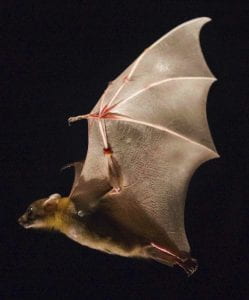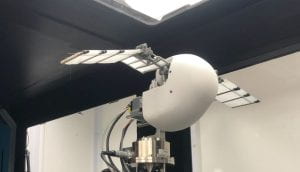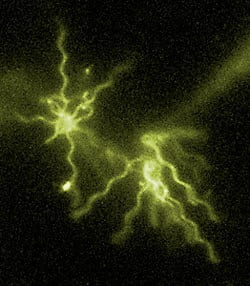Our lab works on an unusually broad range of research topics, covering a wide range of physical phenomena. Our unifying principle is a fascination with the mechanics of fluids and soft matter. We study both fundamental principles and applications in a wide range of physical systems that range from the nanometer to the industrial scale. We focus on experiments and the development of experimental techniques, but we collaborate closely with theorists and computational scientists.
A few of our key research projects are listed below:
Animal flight and bio-inspired robotics
 For several years, we have studied the aeromechanics of animal flight, understanding both birds and bats utilize their unique morphology to accomplish extraordinary flight performance. For many years, we focused on bat flight, and this continues in close collaboration with Sharon Swartz. More recently, we we are looking bird flight, in collaboration with Ty Hedrick (UNC) and Alex Gerson (UMass). In all these studies we are interested in how animals respond to complex disturbances in the environment, what muscles and sensory systems they use to control flight, and how much energy they require to fly in these complex environments. Our techniques include high speed multiple camera recordings, high speed particle image velocimetry (PIV) of live animal fight, muscle activity measurements (EMG), metabolic measurements using labelled NaBiC, and animal-mounted accelerometry.
For several years, we have studied the aeromechanics of animal flight, understanding both birds and bats utilize their unique morphology to accomplish extraordinary flight performance. For many years, we focused on bat flight, and this continues in close collaboration with Sharon Swartz. More recently, we we are looking bird flight, in collaboration with Ty Hedrick (UNC) and Alex Gerson (UMass). In all these studies we are interested in how animals respond to complex disturbances in the environment, what muscles and sensory systems they use to control flight, and how much energy they require to fly in these complex environments. Our techniques include high speed multiple camera recordings, high speed particle image velocimetry (PIV) of live animal fight, muscle activity measurements (EMG), metabolic measurements using labelled NaBiC, and animal-mounted accelerometry.We also have constructed a series of robotic platforms capable of complex flapping motion so that we can re-create bio-inspired flight and measure forces and flows associated with flapping wings. We have several versions of the “flapperoo” – capable of simple flapping, flapping with folding, and most recently, a model capable of flapping, folding and twisting the wing.

We also develop theoretical dynamical models that use articulate wing-body geometries coupled to inertial and aerodynamic models to predict the motion of animals in flight. Using these models we can simulate three-
dimensional flight behavior of insects, birds and bats due to unsteady wing motions and assess both the aerodynamic and inertial behavior of animals in flight.
In a second theme under bio-inspired robotics, we have two underwater models, one aimed at studying pectoral fin motion for low-speed maneuvering, and one based on seal vibrissae – the facial whiskers of seals that use vortex induced vibrations for sensing and mapping the surrounding flow field.
Leading edge vortex dynamics for energy harvesting and in aerodynamic flows
 Leading edge vortices (LEVs) are common in many applications of unsteady aerodynamics and hydrodynamics. We have two areas of focus here. One concerns the development of novel methods for harvesting energy from tidal and riverine streams that utilize pitching and plunging hydrofoils that exploit the growth of a large leading edge vortex (LEV) as a means to extract energy from a fluid stream.
Leading edge vortices (LEVs) are common in many applications of unsteady aerodynamics and hydrodynamics. We have two areas of focus here. One concerns the development of novel methods for harvesting energy from tidal and riverine streams that utilize pitching and plunging hydrofoils that exploit the growth of a large leading edge vortex (LEV) as a means to extract energy from a fluid stream.
Our work, includes experiments, conducted in a water flume and computational simulations and field experiments of industrial-scale prototypes.
 We alsostudy the growth andbehavior of LEVs on swept wings, particularly resulting from aeroelastic instabilities. For this we have developed experiments using a Cyber-Physical system that simulates the elastic mounting of the wing using a real-time control system to generate arbitrary stiffness, damping and inertial wing characteristics .
We alsostudy the growth andbehavior of LEVs on swept wings, particularly resulting from aeroelastic instabilities. For this we have developed experiments using a Cyber-Physical system that simulates the elastic mounting of the wing using a real-time control system to generate arbitrary stiffness, damping and inertial wing characteristics .
Membrane aeromechanics

Related to, and inspired by our bat flight work, we study the behavior of membranes under aerodynamic loading. We have perfected the fabrication of extremely compliant thin membranes and conduct experiments and develop theory on the interactions between membrane structures (wings, disks) and the surrounding flow. In these experiments, we use time-resolved Particle Image Velocimetry (PIV), and and measure the unsteady membrane kinematic and forces in both wind tunnel and water tunnel environments.
Research topics currently on hold:
These are areas that we still love, and still follow closely, but are not currently pursuing as active projects.
Biophysical flows: Active matter, bacterial motility and flagellar mechanics
 We are interested in the microscope behavior of active fluids – fluids that are energized at the smallest scale by biological motion. This includes systems driven by the motion of kinesin “walking” along microtubule filaments, as well as bacteria that swim using helical flagella. We conduct novel experiments of active matter systems, exploring the collective behavior of these systems under different parametric regimes.
We are interested in the microscope behavior of active fluids – fluids that are energized at the smallest scale by biological motion. This includes systems driven by the motion of kinesin “walking” along microtubule filaments, as well as bacteria that swim using helical flagella. We conduct novel experiments of active matter systems, exploring the collective behavior of these systems under different parametric regimes.Microscale and nanoscale fluid dynamics
We have long been interested in the physics of fluids at the micron and nanometer scale, and the breakdown of the no-slip boundary condition in regions of high shear, such as in close proximity to a moving contact line.
Our experiments includes the development of innovative optical diagnostic techniques using Total Internal Reflection Fluorescence Microscopy that enables velocimetry near the solid surface with nanometer resolution.

